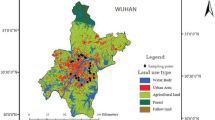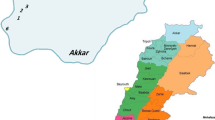Abstract
This study was conducted to evaluate the levels and seasonal variations of some organochlorine pesticides (OCPs) in the cultivated land of Oke-Osun farm settlement, Osogbo, Nigeria. A field sampling programme was conducted in the rainy and dry seasons for 4 months each resulting in the analysis of a total of 40 samples. Soil samples collected at 20-m intervals were air-dried to a constant weight, sieved through a mesh of 2.0-mm pore size and selected by coning and quartering method. Solid–liquid extraction was used to extract OCPs from the soil. Qualitative identifications and quantitative evaluation of the OCPs were carried out with the aid of a Perkin Elmer gas chromatograph coupled with electron capture detector. Seasonal mean ranges of OCPs in soil (μg/kg) were 13.09 ± 21.66 β-BHC–42.01 ± 17.50 p, p′-DDT in rainy season and 30.74 ± 17.38 α-BHC–82.88 ± 32.24 p, p′-DDT in the dry season. The results obtained from this study revealed that agricultural soil samples of Oke-Osun farm settlement were contaminated with persistent organochlorine pesticides mainly as a result of their applications by farmers. Higher levels of OCPs were obtained for dry season than the rainy season. There were indications from this study that pesticides that have deleterious health effects on humans previously placed under legal restrictions by regulatory agencies were still being used by the farmers of Oke-Osun farm settlement and this gives cause for environmental concern.
Similar content being viewed by others
References
Barlow, S. M. (2005). Agricultural chemicals and endocrine-medicated chronic toxicity or carcinogenicity. Scandinavian Journal of Work, Environment & Health, 31(suppl. 141–5), 119–122.
Darko, G., & Acquaah, S. O. (2007). Levels of organochlorine pesticides in meat. Int. J. Environ. Sci. Tech., 4(4), 521–524.
Donkin, P., Widdows, J., Lowe, D. M., Donkin, M. E., & Price, D. N. (1996). In: J. F. Tappi, S. M. Hunt, & J. R. Wharfe (Eds.), Toxic Impacts of Wastes on Aquatic Environment (pp. 138–145).
FAO (2005). AOSTAT statistical database. Rome: Food and Agricultural Organization.
Fatoki, O. S., & Awofolu, R. O. (2003). Methods for selective determination of persistent organochlorine pesticide residues in water and sediments by capillary gas chromatography and electron capture detection. Chromatography A, 983(1–2), 225–236.
Galloway, T., & Handy, R. (2003). Immunotoxicology of organophosphorus pesticides. Ecotoxicology, 12(1–4), 345–363.
Garcia, A. M., Flectcher, T., Benavides, F. G., & Ort, E. (1999). Parental agricultural work and selected congenital malformations. American Journal of Epidemiology, 149(1), 64–74.
Halena, B. A., Vega, M., Barrado, E., Pardo, R., & Fernandez, L. (1999). A case of hydrochemical characterization of an alluvial aquifer influenced by human activities. Water, Air and Soil Pollution, 112, 365–387.
Harris, D. C. (1999). Quantitative chemical analysis (5th ed.). New York: W.H. Freeman and Company.
Kabata-Pendias, A., Dudka, S., Chlopecka, A., & Gawinowska, T. (1992). Background levels and environmental influences on trace metals in soils of the temperate humid zone of Europe. In: D. C. Adriano (Ed.), Biogeochemistry of Trace Metals (pp. 61–84). UK: Lewis Publishers.
Kamel, F., & Hoppin, J. A. (2004). Association of pesticide exposure with neurologic dysfunction and disease. Environmental Health Perspectives, 112(9), 950–958.
Manirakiza, P., Akimbamijo, O., Covaci, A., Adediran, S. A., Cisse, I., Fall, S. T., & Schepens, P. (2002). Persistent chlorinated pesticides in fish and cattle fat and their implications for human serum concentrations from the Sene-Gambian region. Journal of Environmental Monitoring, 4, 609–617.
McAloon, K. M., & Mason, R. P. (2003). Investigations into the bioavailability and bioaccumulation of mercury and other trace metals to the sea cucumber, Sclerodactyla briareus, using in vitro solubilization. Marine Pollution Bulletin, 46, 1600–1608.
Miller, J. N., & Miller, J. C. (2000). Statistics and Chemometrics for Analytical Chemistry (4th ed., pp. 271). Pearson Education Limited.
Ogunfowokan, A. O. (1992). Determination of Phthalate esters in Surface Waters of South Western Nigeria. M.Sc. thesis, Department of Chemistry, Obafemi Awolowo University, Ile-Ife, Nigeria.
Ogunfowokan, A. O., Asubiojo, O. I., & Fatoki, O. S. (2003). Isolation and determination of polycyclic aromatic hydrocarbons in surface runoff and sediment. Water, Air and Soil Pollution, 147, 245–261.
Ogunfowokan, A. O., Torto, N., Adenuga, A. A., & Okoh, E. K. (2006). Survey of levels of phthalate ester plasticizers in a sewage lagoon effluent and a receiving stream. Environmental Monitoring and Assessment, 118, 457–480.
PAN (2007). Pesticides Action Network Strategic Assessment of the Status of POPs Pesticides Trading in South Western Nigeria (p. 61). Africa Stockpile Programme. www.africastockpiles.net.
Pandey, A. K., & Shukla, L. (1983). Antithyroidal effects of an organophosphorus insecticide, malathion, in Sarotherodon Mossambicus. International Journal of Environmental Studies, 22, 49–57.
Pesticide News (2000). Lindane Banacross European Union. Pesticide News, 49, 6–7.
Pesticide Trust (1995). Lindane—A chemical of the past persists in the future. J. Pesticide Trust, 28, 28–29.
Sankararamakrishnan, N., Sharma, A. K., & Sanghi, R. (2004). Organochlorine and organic phosphorus pesticide residues in ground water and surface waters of Kanpur, Uttar Pradesh, India. Environment International, 31(2005), 113–120.
Settimi, L., Mashina, A., Andrion, A., & Axelson, O. (2003). Prostate cancer and exposure to pesticides in agricultural settings. International Journal of Cancer, 104, 458–461.
The U.S. Ban on DDT: A continuing success story – Environment defence fund. http://www.edf.org/article.cmf. Accessed 15 April 2009.
UNEP-GEF (2002). United Nations Environmental Programme—Global Environmental Facility 2002. Regional based assessment of persistent toxic substances (Central American and the Caribbean Regional Report), Geneva, Switzerland.
Willet, P. (1987). Similarity and clustering in chemical information systems. Chichester: Research Studies Press.
Yucra, S., Rubio, J., Gasco, M., Gonzales, C., Steenland, K., & Gonzales, G. F. (2006). Semen quality and reproductive sex hormones levels in Peruvian pesticide sprayers. International Journal of Occupational and Environmental Health, 12, 355–361.
Author information
Authors and Affiliations
Corresponding author
Rights and permissions
About this article
Cite this article
Oyekunle, J.A.O., Ogunfowokan, A.O., Torto, N. et al. Determination of organochlorine pesticides in the agricultural soil of Oke-Osun farm settlement, Osogbo, Nigeria. Environ Monit Assess 177, 51–61 (2011). https://doi.org/10.1007/s10661-010-1617-y
Received:
Accepted:
Published:
Issue Date:
DOI: https://doi.org/10.1007/s10661-010-1617-y




